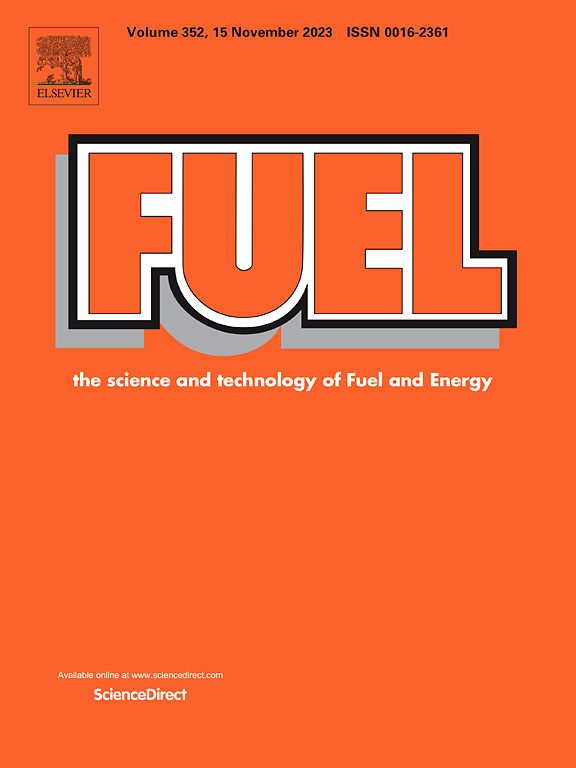不同气氛下石墨对富磷生物质灰熔融性及磷释放特性的影响
IF 7.5
1区 工程技术
Q2 ENERGY & FUELS
引用次数: 0
摘要
在富磷生物质的气化应用中,原料中的磷酸盐可能被残余碳还原,从而改变灰的熔化行为并导致磷释放到气相。在本研究中,测定了两种富磷生物质灰与0-10 wt%石墨混合后在氩气(Ar)和二氧化碳(CO2)下的熔融特性温度。结果表明:在Ar气氛下,随着石墨含量的增加,污泥灰的熔灰温度先降低后升高,而在CO2气氛下,熔灰温度先升高后降低;两种气氛下,石墨的加入均使酒糟灰分的aft增加,且增加幅度更大。在Ar气氛下是显著的。大气中CO2的存在改变了石墨引起的aft变化的幅度。XRD分析、平衡计算和反应热力学参数表明,金属铁、游离SiO2和Al2O3有利于降低含钙磷酸盐碳热反应的热力学温度阈值。金属铁捕获磷后形成的磷化铁化合物具有良好的热稳定性,阻止了磷从灰渣中释放到气相中。在CO2气氛下,石墨与CO2之间的优先反应限制了磷酸盐的碳热反应。通过消解和ICP-OES对1400℃淬火渣中磷含量的测量表明,灰分中石墨含量为5wt %或以上,铁氧化物含量低,大气中CO2浓度低,达到碳热反应的温度阈值是在气化条件下将磷释放到气相的必要条件。本文章由计算机程序翻译,如有差异,请以英文原文为准。
Influences of graphite on the fusibility and phosphorus release characteristics of phosphorus-rich biomass ash under different atmospheres
In gasification applications of phosphorus-rich biomass, phosphates in the feedstock may be reduced by the residual carbon and thus alter the melting behavior of the ash and lead to phosphorus release into the gas phase. In this study, the fusion characteristic temperatures of two phosphorus-rich biomass ashes mixed with 0–10 wt% graphite were determined under argon (Ar) or carbon dioxide (CO2), respectively. Results showed that the ash fusion temperatures (AFTs) of sludge ash decreased and then increased with the increase of graphite content under Ar atmosphere, while it increased and then decreased under CO2 atmosphere. AFTs of distillers’ grains ash increased due to the graphite addition in both atmospheres, and the increase was more.
significant under Ar atmosphere. The presence of CO2 in the atmosphere changed the magnitude of the variation in AFTs caused by graphite. According to XRD analysis, equilibrium calculations and reaction thermodynamic parameters, metallic iron, free SiO2 and Al2O3 facilitated the lowering of the thermodynamic temperature threshold for the carbothermic reaction of calcium-bearing phosphates. The iron phosphide compounds, which formed after the capture of phosphorus by metallic iron, had good thermal stability and prevented the release of phosphorus from the ash slag into the gas phase. Under CO2 atmosphere, the carbothermic reaction of phosphates was limited by the preferential reaction between graphite and CO2. Measurements of the phosphorus content in the 1400°C quenched slag obtained by digestion and ICP-OES indicated that a graphite content of 5 wt% or more in the ash along with a low iron oxide content, a low CO2 concentration in the atmosphere, and the attainment of a temperature threshold for the carbothermic reaction are necessary conditions for the release of phosphorus to the gas phase under gasification conditions.
求助全文
通过发布文献求助,成功后即可免费获取论文全文。
去求助
来源期刊

Fuel
工程技术-工程:化工
CiteScore
12.80
自引率
20.30%
发文量
3506
审稿时长
64 days
期刊介绍:
The exploration of energy sources remains a critical matter of study. For the past nine decades, fuel has consistently held the forefront in primary research efforts within the field of energy science. This area of investigation encompasses a wide range of subjects, with a particular emphasis on emerging concerns like environmental factors and pollution.
 求助内容:
求助内容: 应助结果提醒方式:
应助结果提醒方式:


